Earlier this month I shot my first USPSA match of the season at York IWLA. If you were one of the handful of people who read the nearly four-thousand word match report that I put together, one of the things you learned was that I beat myself up, mentally, in my season opener.
If there was one thing that I wanted to accomplish in my second match this season, it was that no matter what the outcome, good or bad, I was going to wipe each stage clean from my mind after shooting it. I did not want a repeat of the week before where I stepped into the shooting box still dwelling on the performance of the previous stage.
Stage 4: Peek-a-Boo
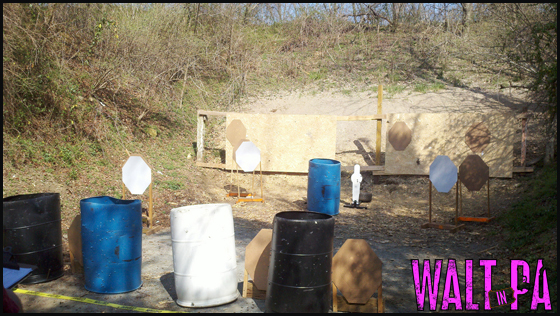
After being squadded, my fellow shooters and I set off to the 15 Yard Range to get started. I’m not sure at this point if I should say ‘Fortunately’ or ‘Unfortunately’, the shooting order was set with me shooting in position three. We did not rotate shooters and I spent the entire day as our third shooter for each stage.
There was some good and some bad to a fixed shooting order like this. The good was that I was forced into a position to create a stage-plan quickly and I had to stick with it (there was simply no time to change it once we got started). As a result, I had to drill my plan into my memory and not make tweaks after seeing other shooters hit the stage (which I tend to do).
The downside to to shooting third was that I couldn’t make tweaks to my plan based on seeing others shoot the stage. It was sort of like being self-taught a skill and never seeing examples of other methods before being tested on the material.
Knowing I would have limited time to create a stage plan, I stepped in line for the walk-through and got to work. The tricky part of this stage was that it required a minimum of 22 rounds, which meant that I would need to reload twice throughout the stage. Both of those reloads would wind up falling in inconvenient locations due to target placement.
After The Buzzer
I situated myself so that when the buzzer sounded, I would first engage two low targets at ‘almost close enough to reach out and touch with my muzzle’ distance. After four shots, I shifted my stance and began engaging three other targets further downrange. After ten shots my gun was dry and I performed a slide lock reload, using the first round to drop a steel popper.
After eleven shots, I began moving to the second portion of the stage. The second half was, more or less, a mirror image of the first. I first engaged a steel popper and transitioned to the two low targets at extremely close range. I engaged to targets further downrange before running my gun dry for the second time.
It was at this point that I ran into trouble. My slide was locked back but my magazine wouldn’t drop free after pressing the magazine release button. I gave the gun a little shake to try and free the magazine but was unsuccessful. Being the first time I had ever encountered this problem, I acted on instinct. I mashed down on the slide release lever and the slide snapped forward. A press on the magazine release lever sent the empty magazine falling to the ground. I re-inserted a new magazine and racked the slide.
With a round in the chamber and the slide in battery, the gun appeared ready to rock. I raised the gun and fired two last shots on the one remaining target.
Scoring
After I showed the range officer a clear gun and re-holstered, I knew that my time was going to suffer from the odd malfunction that I experienced. My overall time was 22.92 seconds with 110 points on the stage. Looking at the scores and based off of what I remember, I believe 110 points is a cleared stage (All steel down and all A Zone shots).
This stage set the tone for the day. Right off the start I felt like I was fumbling with my gun and I wasn’t hitting my stride in terms of speed. Rather than the usual panic of trying to make up for the slow start, I just relaxed and found a pace that allowed me to shoot accurately.
At that split second, I decided that I’d rather have a mediocre time and above average accuracy than the other way around. In the end, my performance earned me 14th place out of 27 Shooters in USPSA Production Division.
Stage 5: Uphill Battle
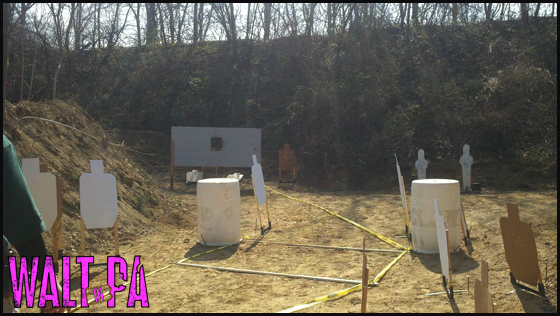
After resetting the stage for our last shooter, we began the long walk to the back ranges for stages five and six. During my walkthrough of the back ranges last month, for the Stage Design Seminar, I got a look at a small range that was still in the process of expansion. I was surprised to see the range completed and setup as a 24 round course of fire with a fair amount of movement.
This stage had a unique condition that I hadn’t experienced before. There were two steel poppers setup towards the rear of the stage. Those two pieces of steel had to be engaged from behind a fault line that did not apply to anything but those steel targets. If you stepped over the fault line, you were hit with a procedural penalty for each shot fired. If you stepped beyond the fault line, and crossed a second fault line, engaging the steel would call for a match disqualification due to safe steel distances.
Being confident in my ability, I opted to shoot the steel from the start position and not have to worry about either fault line. It would mean that I had to engage steel about 3 yards farther away, but I wasn’t too concerned.
After The Buzzer
I situated myself to draw and engage a close range target on my right, then work counter clockwise. After engaging a second target with my fourth round, I transitioned to the steel at what would have been the twelve-o’clock position. I missed my first shot but quickly made it up, dropping that piece of steel and the one next to it.
At this point I opted to reload before engaging targets at roughly nine and seven o’clock. At this point I began to move downrange and engaged targets tucked away on my right and left, then a longer distance shot on a paper target to my right.
I reloaded and engaged a lone target, on the move, before coming to a stop infront of a port. I engaged a target directly infront of me and angled targets to its left and right. I felt like I pulled one of my shots and made it up before closing out the stage.
Scoring
When the dust settled (and I mean that literally, I had really fine sand/dust all over my discarded magazines), my time was a lackadaisical 20.49 seconds. In terms of time, I was in the middle of the pack with the fastest shooter running through the stage at a mere 10.68 seconds and the slowest came in at 36.60 seconds.
While my speed was lacking, accuracy was above average. I scored 116 points on the stage with only one shooter pulling down more points at 118. Between my time and score, I earned 14th place out of 27 shooters in USPSA Production Division.
Stage 6: Can You Count
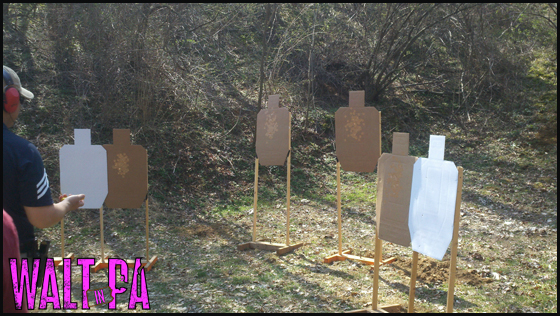
When our squad stepped onto stage six, there was a mix of excitement and dread. We were to shoot the classifier stage Can You Count (CM06-03) . This particular classifier is very fast paced and requires a reload in the middle of what some would call controlled chaos.
. This particular classifier is very fast paced and requires a reload in the middle of what some would call controlled chaos.
I was, I guess you could say, indifferent. I shot this particular stage at a USPSA Classifier Match at Topton, back in November. It wasn’t until after the stage was over that I became curious how my time compared to the same stage the year before.
After The Buzzer
This stage is setup in two strings, one mirror of the other. There is really no stage-plan required, you just draw your gun and pump rounds into a target as fast as possible, perform a reload, and pump rounds into a target slightly farther away. Once completed, you holster and do it all over again.
The reason I called this controlled chaos is that shooters tend to get wrapped up in yanking back on the trigger and transition to the next target before their brains stops them before the words ‘Oh My God, Realod!’ race through their minds. I ran into that small hiccup at Topton but I was relaxed and moved through the stage without issue this time around.
Score
Imagine my amazement when the first string was finished and the range officer called out a time of 4.67 seconds. Up until I started shooting USPSA, I always thought that a second was a tiny little segment of time. Here I am drawing a gun, firing 5 rounds on target (all A zone hits), reloading, and firing another 5 rounds on target (again, all A zone hits) in under five seconds. That just blows my mind.
The second string was a bit slower. The last shot on my first magazine was delayed and for some reason shot out of rhythm. My reload wasn’t as good the first string but I still managed to draw my gun, perform a reload, and fire ten shots in 5.11 seconds.
I had a combined time of 9.78 seconds and 100 points (perfect score for this stage), earning me 4th place out of 27 shooters in USPSA Production Division. The most interesting thing here comes by the way of comparing this stage to the same stage shot at Topton in November (14.39 Seconds and all A Zone Hits).
Stage 1: Hogan’s Alley
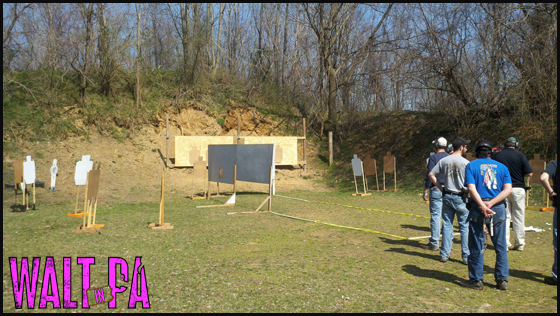
After a hike back around to the front ranges, we dropped our gear on the 75 yard range and waited for the squad ahead of us to finish up. We found a spot in the shade and enjoyed snacks, beverages, and conversation. I can only describe our squad as awesome. We were hustling, without rushing, and everyone helped with resetting stages.
After our pleasant break, we got back to business and began out stage walkthrough. During our break, I should have been paying closer attention to the shooters ahead of us. Instead, I payed little attention to them and wound up creating a stage plan based solely on my walkthrough.
After The Buzzer
I situated myself on a hard angle, with my heels on the start marks, so that I wouldn’t waste time shifting after the draw. I worked the stage counter-clockwise, firing eight shots at the first four targets. I performed a reload and engaged two more targets at increased distance before turning to my left and engaging another pair of targets.
While engaging those four targets, I felt like I pulled two shots and made them up along the way. I reloaded, where I wasn’t planning, before moving to engage a lone target setup tight against a wall. I turned and engaged two pieces of steel. One of those steel poppers introduced me to my first out-and-back. Unlike the swingers that I was used to, this target had a short stroke before dipping back behind cover. I setup to ambush it and fired three rounds before it disappeared.
I performed one last reload and opted to move downrange to engage two pairs of targets, one pair through a port. This is where I could have gambled but didn’t think to until watching other shooters. These four targets could have been shot further away to save time. That strategy paid off for some and seriously hurt the scores of others.
Scores
Taking my sweet old time on this stage didn’t hurt me as much as I thought. I shot this stage in 35.96 seconds with a score of 146 points. I’m not sure what the maximum stage points were but my score was the highest (and I’m absolutely sure that I didn’t shoot all A’s).
My solid accuracy and middle of the pack speed earned me 13th place out of 27 shooters in USPSA Production Division. Looking at the other shooters’ times, I have to wonder what the outcome would have been if I didn’t move towards the end of the stage and instead taken a risk on the last four targets.
I think it would have had to shave a significant amount of time off of my overall score to make much of a difference. The shooter that placed just ahead of me shot the stage a full 10 seconds faster than I did.
Stage 2: Countdown
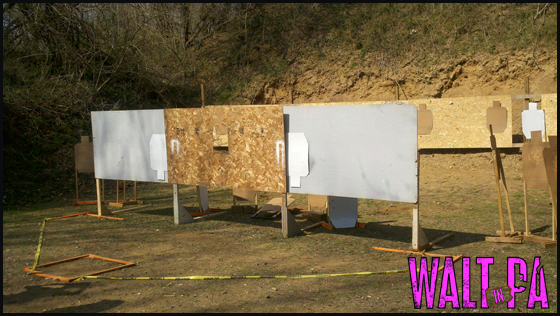
If there were any stages in the match that I had the upper hand on, I guess you could say that it would be this stage. I arrived early to help setup and was put in change or constructing this stage. Despite spending a considerable amount of time setting it up, with a group of volunteers, I spent very little time considering how I would shoot it.
The stage itself was fairly straight forward but due to the number of targets setup on a backer board, it was possible to loose track of one of them as you moved from one shooting position to the next. My plan was simply to start on the left and move right, running my gun dry before transitioning to the next shooting position.
After The Buzzer
At the buzzer I drew my gun and began moving to the left-most shooting position. I engaged two targets as I got into position then transitioned to targets stapled to the backer at the rear of the range. I ran my gun dry and reloaded while getting into position at the port.
From the port I engaged three low targets, at close range, before transitioning back to the backer at the rear of the range. I engaged two targets, running my gun dry again, and reloaded as I moved to the right-most shooting position. From the last position I engaged two targets at close range and transitioned to the backer board one last time to engage another three targets.
Scoring
When the scores were release, I was most surprised with my results here. I thought that of any stage, I probably had the best mix of speed and accuracy right here. It was disappointing to see that I earned 15th place out of 27 shooters in USPSA Production Division with a time of 23.75 seconds and 146 points.
Watching the video back, I can see that I need to pick up the pace and get into position as quickly as possibly. The same is true for transferring from one position to another. I’m not sure what the cause was, but at the last shooting position I was shooting very slow. I took a terribly long time breaking the shots at the two closes targets, which were close enough that as long as the front sight post was somewhere between the rear notch I would have been close enough for good hits.
If I would have sped things up and shaved about 4 seconds off of my time, I think I may have broken into the top 10.
Stage 3: Paddy’s Revenge
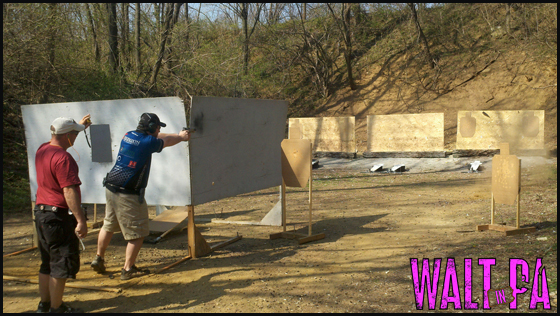
Like we did a few times throughout the day, our squad hustled and got through the stage before the squad ahead of us was finished shooting. We shuffled into the covered area and took a quick break in the shade while the others shooters finished up. By this time I had been at the range for roughly seven hours. Between the early setup and shooting in the sun, I was sweaty, tired, and ready to head home.
Our break didn’t last long and we were quickly back in the sun performing our walkthrough. The most important part of this stage was the start. Facing up-range, wrists above shoulders (surrender position), we were to turn and move into position to shoot. If a shooter got sloppy and drew their gun too early, it would be a disqualification for breaking the 180 degree safety rule.
After The Buzzer
I choose to take the safe route, turn and begin moving before I drew my gun. With three shooting positions, I opted to turn toward my gun and move to the left-most shooting position. I engaged two close range targets, transitioned to a steel popper, and engaged two far paper targets.
I reloaded my pistol while moving to the center shooting position, a port. The location of the port was kind of tall and I felt a bit akward getting the gun in a position to shoot down on a target just through the port. I then transitioned back down range and engaged two pieces of steel.
My last reload was performed late and I wound up standing infront of a target for a second before my gun was ready to fire. I engaged two close targets and transitioned back to the rear of the range for a piece of steel and two more paper targets.
Scoring
The scoring on this stage was the most amusing of the day. When this stage was called safe and we began walking and scoring, I winced at the mixture of A’s, C’s, and D’s. It was easily my worst stage of the day and I expected to find myself towards the bottom of the stage placement.
To my amusement, the stage I felt that I did the worst on, I placed 8th place out of 27 shooters in USPSA Production Division. It would seem that the balance that I was holding all day, sacrificing speed for accuracy, was flipped on this stage. As a result, I climbed higher in the rankings than I anticipated. My stage time came in at 17.94 seconds with 100 points.
At The End of the Day
At the end of the day, I was fairly happy with my performance. I earned 12th place out of 27 shooters in USPSA Production Division. Unlike my previous match at York, I was completely relaxed at Southern Chester. I don’t know if that was a byproduct of shooting early in the rotation and busying myself with resetting stages or if I was simply more relaxed. Whatever the reason for being more relaxed, I had a great time.
I am happy with how I sort of defaulted to accuracy over speed when things didn’t go precociously as planned. I’ve already seen a tremendous improvement in my ‘slow’ shooting speed since I’ve started. I’m sure it will improve even more and become faster as I compete in more and more USPSA Matches.
While taking my time to make well placed shots is all fine and good, in my mind, I definitely need to work on picking up the pace between shots. In the future I want to be breaking the fist shot the second I get into position and firing the last shot as I move out of position.
5 thoughts on “USPSA at Southern Chester (March 2012)”
Comments are closed.
Recent Posts
From Group Ride Roasts to Real Life: My YouTube Channel Update
Well, my lovelies (I realize that sounds weird but at this point I need to lean into it), it's time for some real talk about where I've been and what's been happening behind the scenes at Walt in...
Reconnecting with friends, exploring scenic Pennsylvania back roads, and enjoying the simple pleasure of two wheels Getting the Band Back Together Today was a pretty special day in the...

Good shootin’ Tex.
Very good job with the videos. the PiP gives a great overview of the stage. Although I find myself giving you IDPA penalties 🙂
Miguel,
Thanks, I’m glad you enjoyed the videos. The PiP effect is a bit of a headache when it comes to syncing up both videos but I like what it adds to the stage video.
I can only imagine the penalties I’d be looking at. Not using cover, dumping magazines, shooting targets out of sequence.
Good job on the write-up Walt, I see the dry fire reload pratcice is paying off with your smooth reloads.
Another great match report. I love your self-examination. I think you’re right – helping score and re-set the stage helps me relax, too.
I agree with Nick, your reloads look smooth.
Also, I would observe that, when I read your description of the malfunction on Stage 4, I fully expected you to take 4 or 5 seconds to clear it. But in the video, it looked like you just cleared it and went on. I probably wouldn’t have known you hit a malfunction if you hadn’t said anything.
I think this is a demonstration of the time dilation that occurs under stress. Everything seems to slow down to us, like the fight scenes in Sherlock Holmes. It probably seemed like 10 seconds to you at the time, too.
Something I learned shooting IDPA matches is not over-analyze screw ups. After I am done with a stage, I check the targets with the score keeper then take all of two minutes mentally reviewing what worked and what didn’t and forget about the stage.
In my early shooting days, I used to get upset at my screw ups till a veteran shooter pulled me aside and asked me if I knew what I did wrong in a particular stage. I said yes and he simply said “Well, don’t do it again.” I had to laugh, the solution was simple but I didn’t want to forgive myself for screwing up.
Walt, Have serious fun but don’t be too serious. If you start feeling like you are doing a job, you lose.